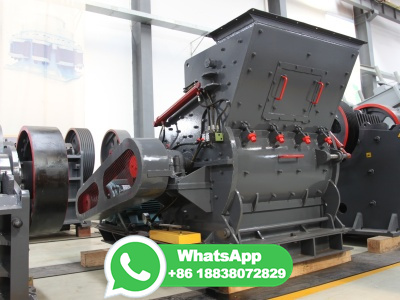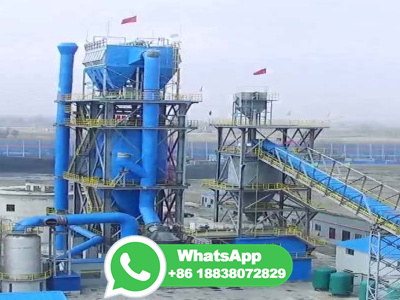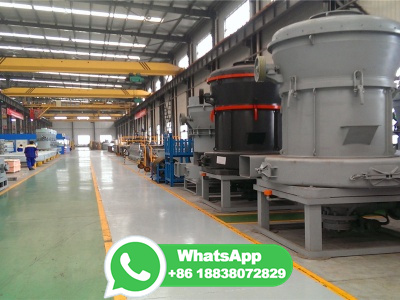
Introduction: The Case for Clean Coal. The world demand for electricity has increased linearly by an average of % from 1974 to 2018, except for brief drops in 1974, 2009, and 2019 that coincide with economic recessions, to a total of 26,730 terawatthours (TWh). The global demand is driven by the twoblock of countries.
WhatsApp: +86 18037808511
This chapter presents an assessment of the technologies that have evolved for the gasification of coal with a description of the current state of the art of the various technologies. Various types of coal are available such as lignite, subbituminous coal, bituminous coal, and anthracite. The gasification process involves two distinct stages ...
WhatsApp: +86 18037808511
2.
WhatsApp: +86 18037808511
Electron spin resonance (ESR) is a spectroscopic method to detect paramagnetic species, which has been applied in coal and coal conversion research over 60 years. The major advancements made before 1990s were reviewed but the studies and findings reported since then have not been reviewed. The recent studies not only showed new phenomena on ESR radical behaviors associated with coal conversion ...
WhatsApp: +86 18037808511
The ESR studies on coals and coal derived maters have been carried out for over 60 years. The main works before 1990s were the determination of origin of ESR signals, quantification of spin concentration, g value, linewidth and line shape, and correlating the ESR results with pyrolysis and DCL reactions.
WhatsApp: +86 18037808511
The hydrogen required for this method is produced using electrolysis processes with electricity generated from renewable energy sources. Overall, this could reduce carbon dioxide emissions by up to 97%. The decarbonization of the steel industry would therefore contribute significantly to protecting the climate.
WhatsApp: +86 18037808511
Biomass gasification is a mature technology pathway that uses a controlled process involving heat, steam, and oxygen to convert biomass to hydrogen and other products, without combustion. Because growing biomass removes carbon dioxide from the atmosphere, the net carbon emissions of this method can be low, especially if coupled with carbon ...
WhatsApp: +86 18037808511
Other energyconversion systems are decidedly more complex, particularly those that take raw energy from fossil fuels and nuclear fuels to generate electrical power. Systems of this kind require multiple steps or processes in which energy undergoes a whole series of transformations through various intermediate forms.
WhatsApp: +86 18037808511
Gasification of coal is a process whereby coal is converted to a syngas, which is predominately a mixture of carbon monoxide and hydrogen.
WhatsApp: +86 18037808511
As the names imply, direct processes directly convert coalbased hydrocarbons into liquid fuels, while indirect processes use an intermediate process (gasification) to convert the coal into a gaseous fuel (syngas) before further refining the syngas into liquid fuels. Exhibit 21 gives a general overview of the processes involved.
WhatsApp: +86 18037808511
1 Introduction Coal is a combustible sedimentary rock formed from ancient vegetation which has been compressed between other rock strata. The vegetation was accumulated under conditions that either limited or inhibited its decay.
WhatsApp: +86 18037808511
Solid powder that can last for decades. By contrast, the new process achieves a conversion of well over 90 percent and eliminates the need for the inefficient heating step by first converting the carbon dioxide into an intermediate form, liquid metal bicarbonate. That liquid is then electrochemically converted into liquid potassium or sodium formate in an electrolyser that uses lowcarbon ...
WhatsApp: +86 18037808511
The primary liquid emissions from coal conversion processes are heavily contaminated by ammonia, sulphides and other inorganics, as well as by phenolic and other organic compounds. The solid wastes are derived from coal ash, spent catalyst, and solid sludges. Previous chapter Next chapter 1. Introduction 62 2. Gasification 65
WhatsApp: +86 18037808511
Although the processing of coal is an ancient problem and has been practiced for centuries, the constraints posed on today's coal conversion processes are unprecedented, and utmost innovations are required for finding the solution to the a strong demand for an affordable energy supply which is compounded by the urgent need for a CO2 emission control, the clean and efficient ...
WhatsApp: +86 18037808511
Determine an energy and mass balances for this process and report how much energy was contained in each of the coproducts as well as the overall conversion efficiency. Solution. 1. Draw a schematic of the complete mass and energy balance process as in Figure (PageIndex{11}). 2. Calculate the energy contained in the original biomass as:
WhatsApp: +86 18037808511
Coal and biomass are important feedstocks for carbon energy from thermochemical conversion process. Fully understanding the analytical technology that characterizes the changes in physicochemical properties and structural characteristics of coal and biomass during the thermochemical reactions is a key prerequisite for the realization of appropriate utilization of energy fuels.
WhatsApp: +86 18037808511
Energy conversion efficiency ( η) is the ratio between the useful output of an energy conversion machine and the input, in energy terms. The input, as well as the useful output may be chemical, electric power, mechanical work, light (radiation), or heat. The resulting value, η (eta), ranges between 0 and 1. [1] [2] [3]
WhatsApp: +86 18037808511
Influence of coal properties on coal conversion processal carbonization, carbon fiber . 123 Table 5 Coal parameters with significant influence on liquefaction process
WhatsApp: +86 18037808511
Generally, biomass gasification is an endothermic thermochemical conversion of solid biomass fuel using gasifying agents such as air, steam or CO 2 to form a mixture of combustible gases which may include H 2, CH 4, CO and CO 2. The process is carried out at temperatures between 800 and 1300°C.
WhatsApp: +86 18037808511
1.. IntroductionExergy analysis on combustion and energy conversion processes has already been studied by many researchers [5], [6], [7], [8].The performance of a thermoelectric power station was checked by energy and exergy analyses for innovation of facility or system [5].Furthermore, a new heat pumpboiler system was introduced for subway heat recovery and was checked by energy and exergy ...
WhatsApp: +86 18037808511
The FischerTropsch process (FT) is a collection of chemical reactions that converts a mixture of carbon monoxide and hydrogen, known as syngas, into liquid reactions occur in the presence of metal catalysts, typically at temperatures of 150300 °C (302572 °F) and pressures of one to several tens of FischerTropsch process is an important reaction ...
WhatsApp: +86 18037808511
Most of the difference between these values was lost as an inherent result of the energy conversion process. The Energy Information Administration's (EIA) electricity flow diagram visualizes electricity flow from energy sources consumed to generate electricity and electricity net imports to disposition (conversion and other ...
WhatsApp: +86 18037808511
This chapter introduces the foundations of the exergy, exergy production cost, and renewability analysis of energy conversion processes. Based on the concept of reversible work, the concept of exergy is derived and the exergy balance is presented as a combination of the energy and entropy balances. Some graphical representations are shown in ...
WhatsApp: +86 18037808511
In a motor the energy conversion process can be thought of in simple terms. In "steady state", electric power input to the machine is just the sum of electric power inputs to the different phase terminals: Pe = ∑iviii. Mechanical power is torque times speed: Pm = TΩ. And the sum of the losses is the difference: Pd = Pe − Pm.
WhatsApp: +86 18037808511
MODELING STUDY OF COALTOGAS CONVERSION AT TRENTONCHANNEL STATION. The objective of this project was to provide an initial indication of issues which may arise when switching from coal to natural gas firing. Both process modeling and CFD modeling were performed. A baseline coaloperation steam and flue gas circuit was generated in REI's ...
WhatsApp: +86 18037808511
Coal gasificationbased processes for conversion of coal to liquid fuels and chemicals have been in commercial operation for considerably longer than gasification for power generation. Methods for the conversion of coal to liquid fuels (CtL) have been available since the 1930s, but widespread acceptance of the technologies has been hindered by ...
WhatsApp: +86 18037808511
Coal Conversion In addition to its direct use for combustion, coal can be converted to organic gases and liquids, thus allowing the continued use of conventional oil and gasfired processes when oil and gas supplies are not available. Currently, there is little commercial coal conversion in the United States.
WhatsApp: +86 18037808511
Thermal Conversion Biomass can be burned by thermal conversion and used for energy. Thermal conversion involves heating the biomass feedstock in order to burn, dehydrate, ... Algae has enormous potential as an alternative energy source. However, processing it into usable forms is expensive. Although it is estimated to yield 10 to 100 times more ...
WhatsApp: +86 18037808511
• Energy Conversion is the process of changing energy from one form to another Energy Source Useful Energy Energy Conversion Sustainable Energy Fall 2010 Conversion 3 . Historic Energy Conversion Sequences • Biomass → heat (esp. cooking) • Solar → heat, dry clothes, dry food
WhatsApp: +86 18037808511
Miller EIA 2007 03/28/07 Department of Energy 4 Coal Conversion Processes Carbonization and Pyrolysis Low severity (mild gasification) High temperature Direct Liquefaction Onestage reactor technology ... "Coal Conversion A Rising Star," 23rd Int'l Pittsburgh Coal Conference, September 25 28, 2006. Mild Pyrolysis ...
WhatsApp: +86 18037808511
Between 2017 to 2019, coal production declined by 9%, mostly because of decreasing global coal demand and increasing competition from natural gas. coal production decreased by an additional 24% in 2020 because of a coal surplus in 2019 coupled with lower electricity demand due to pandemicrelated economic impacts.
WhatsApp: +86 18037808511